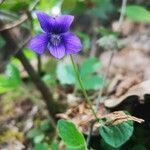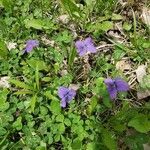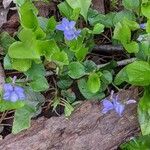Plants perennial, caulescent, not stoloniferous, 1.8–30(–35) cm. Stems 1–5, erect, ascending, or decumbent, sometimes later reclining to nearly prostrate, glabrous or puberulent, on caudex from subligneous rhizome. Leaves basal and cauline; basal: 1–4; stipules linear to linear-lanceolate, margins entire or laciniate with gland-tipped projections, apex acute to acuminate; petiole 0.5–13.5 cm, glabrous or puberulent; blade usually ovate or ovate-deltate to ovate-orbiculate, sometimes ± reniform or oblong, 0.5–6.9 × 0.4–5 cm, base cordate, subcordate, truncate, or attenuate, usually decurrent on petiole, margins crenate to crenulate or entire, ciliate or eciliate, apex acute to obtuse, surfaces glabrous or sparsely to densely puberulent; cauline similar to basal except: stipule margins lacerate to laciniate; petiole 0.5–6.5 cm; blade 0.6–5.5 × 0.4–4.7 cm. Peduncles 1.7–13.8 cm, glabrous or puberulent. Flowers: sepals lanceolate, margins ciliate or eciliate, auricles not enlarged in fruit, 0.5–2 mm; petals light-to deep-to lavender-violet on both surfaces, rarely white, lower 3 usually white basally, dark violet-veined, lateral 2 (and sometimes upper 2) bearded, lowest 7–17(–23) mm, spur purple to violet or white, elongated, 5–7 mm, tip straight or pointed, curved up or lateral; style head sparsely to densely bearded, sometimes beardless; cleistogamous flowers axillary. Capsules short-ovoid, 6–11 mm, glabrous. Seeds dark brown to olive-black, 1.5–2 mm.
More
Tufted on short or elongate rhizomes, at first anthesis erect, 2–8 cm, and nearly acaulescent, later to 15 cm and more spreading or prostrate, with evidently leafy stems; lvs darker green arid thicker than in no. 24 [Viola conspersa Rchb.], ovate to suborbicular, obtuse, crenulate, subtruncate to subcordate at base, mostly 1–2.5(–3) cm wide; stipules lance-linear, with fimbriate-incised teeth above the middle; peduncles elongate; sep narrowly lanceolate, not ciliate; pet violet, the lateral ones bearded; spur 4–6 mm, straight and blunt, or often tapering to a short, incurved point; style slender, bent at the tip; frs 4–5 mm, ellipsoid; seeds dark brown; 2n=20, 40. Sandy or gravelly, moist or sometimes dry soil; Greenl. and Lab. to Alas., s. to N.Y., Mich., Minn., and Calif. May–July. The widespread and highly variable var. adunca is ± puberulent. (V. arenaria; V. subvestita) Var. glabra Brainerd, more boreal or in our range more alpine, is essentially glabrous
A spreading herb. It grows 5-10 cm high and spreads 30-40 cm wide. It keeps growing from year to year. It forms tufts. The leaves are rounded to heart shaped. They are 40 mm long. The flowers are blue to violet. They are 12 mm wide. The fruit is a dry capsule with 3 valves. It has many seeds.
Can be grown by divisions or seedlings. Seeds needs stratification.






